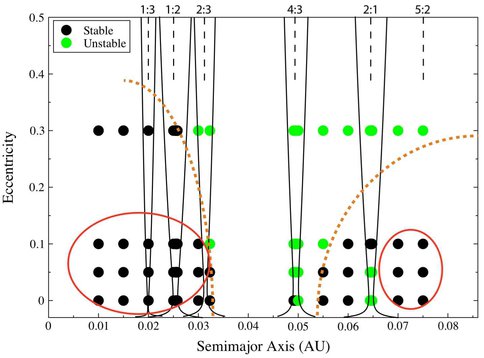2009 Annual Science Report
 University of Hawaii, Manoa
Reporting | JUL 2008 – AUG 2009
University of Hawaii, Manoa
Reporting | JUL 2008 – AUG 2009
Detection of Super-Earths Using Transit Timing Variation Method
Project Summary
Jupiter-like planets may orbit their parent stars in very close distances and reduce their brightness by blocking some of their lights. A second planets with a mass several times more than the Earth in such systems can disturb the orbit of the Jupiter-like planet and causes its transit to occur at different times. By measuring the time between these transit we can determine the size and orbit of the perturbing planet.
Project Progress
Short-period terrestrial-class and Super-Earth objects are predicted to be captured into near mean-motion resonant orbits with migrating giant planets. These objects are potentially detectable via transit photometry of their host stars, or the measurement of the variations of the transit-timing due to their close-in Jovian-mass planetary companions. The latter, also known as the TTV method, is particularly efficient in detecting small close-in planets in resonant orbits. Haghighipour and collborator Eric Agol from the University of Washington, started an an expansive project on the study of the capability of the TTV method in detecting close-in Super-Earth objects. They and have identified regions of the parameter-space for which such planets will produce strong TTV signals. Haghighipour has also studied the effects of interior and exterior mean-motion resonancces on the detectability of Super-Earths, and has been able to show that for a tidally locked Jovian body, a Super-Earth planetary companion has a greater chance of detection if it has a long-term stable orbit with a low eccentricity and a low inclination (figure 1). Two of Haghighipour’s student have also been involve din this project. The results of their studies indicate that low-order mean-motion resonances, such as 1:2 and 1:3 resonances, cause strong enhancements in TTV signals and present most probable configurations for the detection of Super-Earth objects. Trojan planets in 3 to 10 day orbits and with eccentricities ranging from 0 to 0.15 will also have a high probability for detection especially around M dwarfs.
Graph of stability for an Earth-size planets in a
transiting system. The central star is Sun-like.
The transiting planet (not shown here) is Jupiter-like in a 3-day circular
orbit at 0.0407 AU. The circles
correspond to the values of the semimajor axis and eccentricity
of the Earth-like planet at the beginning of each simulation. The orange
dotted lines show the boundaries of the unstable region for an Earth-size
planet. The red
circles present conservative regions of the stability of a
terrestrial-class object.
Publications
- Capen, S. & Haghighipour, N. (2009). DetectabilityOf Low‐Mass Trojan Planets In Transiting Systems Using Transit Timing Variation Method. BAAS, submitted.
-
PROJECT INVESTIGATORS:
-
RELATED OBJECTIVES:
Objective 1.2
Indirect and direct astronomical observations of extrasolar habitable planets.


